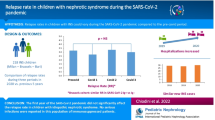Abstract
Background
The etiology of idiopathic nephrotic syndrome (INS) remains partially unknown. Viral infections have been reported to be associated with INS onset and relapse. The aim of this study was to describe the epidemiology of a population-based cohort of children with INS and propose a spatiotemporal analysis.
Methods
All children aged 6 months to 15 years with INS onset between December 2007 and May 2010 and living in the Paris area were included in a prospective multicenter study. Demographic and clinical features at diagnosis and 2 years were collected.
Results
INS was diagnosed in 188 children, 93 % of whom were steroid sensitive. Annual incidence was 3.35/100,000 children. Standardized incidence ratio (SIR) was higher in one of the eight counties: Seine-Saint-Denis, with SIR 1.43 [95 % confidence interval (CI) 1.02–1.95]. A spatial cluster was further identified with higher SIR 1.36 (95 % CI 1.09–1.67). Temporal analysis within this overincidence area showed seasonal variation, with a peak during the winter period (p <0.01). In addition, partition of the Paris area into quintiles of the population showed that the average delay of occurrence, with regard to the first study case, followed a longitudinal progression (p <0.0001).
Conclusion
The clustering of cases, the seasonal variation within this particular area, and the progression over the Paris area altogether suggest that INS may occur on an epidemic mode.








Similar content being viewed by others
References
Yap HK, Han EJ, Heng CK, Gong WK (2001) Risk factors for steroid dependency in children with idiopathic nephrotic syndrome. Pediatr Nephrol 16:1049–1052
Toyabe S, Nakamizo M, Uchiyama M, Akazawa K (2005) Circannual variation in the onset and relapse of steroid-sensitive nephrotic syndrome. Pediatr Nephrol 20:470–473
Odaka J, Kanai T, Uehara R, Kusano E, Yamagata T (2015) Seasonal variation in first episode of childhood idiopathic steroid-sensitive nephrotic syndrome and adult minimal change nephrotic syndrome. Clin Exp Nephrol 19:146–147
Hodson E, Craig J, Willis N (2002) Congenital and idiopathic nephrotic syndrome. In: Ninth Annual Report Australian Paediatric Surveillance Unit. Eliott E, Australia, pp 6–8
Wong W (2007) Idiopathic nephrotic syndrome in New Zealand children, demographic, clinical features, initial management and outcome after twelve-month follow-up: results of a three-year national surveillance study. J Paediatr Child Health 43:337–341
El Bakkali L, Rodrigues Pereira R, Kuik DJ, Ket JC, van Wijk JA (2011) Nephrotic syndrome in The Netherlands: a population-based cohort study and a review of the literature. Pediatr Nephrol 26:1241–1246
Chuan PL, Leng SC, Sinniah R (1975) Five-year review of nephrotic syndrome in Singapore children. J Singapore Paediatr Soc 17:113–123
Sharples PM, Poulton J, White RH (1985) Steroid responsive nephrotic syndrome is more common in Asians. Arch Dis Child 60:1014–1017
McKinney PA, Feltbower RG, Brocklebank JT, Fitzpatrick MM (2001) Time trends and ethnic patterns of childhood nephrotic syndrome in Yorkshire, UK. Pediatr Nephrol 16:1040–1044
Feehally J, Kendell NP, Swift PG, Walls J (1985) High incidence of minimal change nephrotic syndrome in Asians. Arch Dis Child 60:1018–1020
Schlesinger ER, Sultz HA, Mosher WE, Feldman JG (1968) The nephrotic syndrome. its incidence and implications for the community. Am J Dis Child 116:623–632
French National Authority for Health (2008) Idiopathic nephrotic syndrome in children. French National Authority for Health: 1–22
Azib S, Macher MA, Kwon T, Dechartres A, Alberti C, Loirat C, Deschênes G, Baudouin V (2011) Cyclophosphamide in steroid-dependent nephrotic syndrome. Pediatr Nephrol 26:927–932
Dossier C, Sellier-Leclerc A-L, Rousseau A, Michel Y, Gautheret-Dejean A, Englender M, Madhi F, Charbit M, Ulinski T, Simon T, Jacqz-Aigrain E, Deschênes G (2014) Prevalence of herpesviruses at onset of idiopathic nephrotic syndrome. Pediatr Nephrol 29:2325–2331
Tripepi G, Jager KJ, Dekker FW, Zoccali C (2010) Stratification for confounding--part 2: direct and indirect standardization. Nephron Clin Pract 116:c322–c325
Breslow N, Day N (1993) Statistical methods in cancer research: the design and analysis of cohort studies. Int Agency Res Cancer: 406
Johnson SC (1967) Hierarchical clustering schemes. Psychometrika 32:241–254
Levine N (2013) CrimeStat IV: A spatial statistics program for the analysis of crime incident locations (version 4.0). Houston, TX, and the National Institute of Justice, Washington DC
Mitchell A (2005) The ESRI guide to GIS analysis. VOlume 2 : spatial measurements and statistics
Bithell JF (1990) An application of density estimation to geographical epidemiology. Stat Med 9:691–701
De Smith M, Goodchild M, Longley P (2007) Geospatial analysis : a comprehensive guide to principles, techniques and software tools. Troubadour Publishing Ltd
Larmarange J, Vallo R, Yaro S, Msellati P, Méda N (2011) Methods for mapping regional trends of HIV prevalence from demographic and health surveys (DHS). Cybergeo : Europ J Geography 2011:558
Chang J-W, Tsai H-L, Yang L-Y, Chen T-J (2012) Epidemiology and predictors of end-stage renal disease in Taiwanese children with idiopathic nephrotic syndrome. J Epidemiol 22:517–522
Swaroop S (1957) Index of endemicity. Bull World Health Organ 16:1083–1101
Kalra S, Kumar A, Jarhyan P, Unnikrishnan AG (2015) Endemic or epidemic? measuring the endemicity index of diabetes. Indian J Endocrinol Metab 19:5–7
MacDonald NE, Wolfish N, McLaine P, Phipps P, Rossier E (1986) Role of respiratory viruses in exacerbations of primary nephrotic syndrome. J Pediatr 108:378–382
Blanchoud H, Farrugia F, Mouchel JM (2004) Pesticide uses and transfers in urbanised catchments. Chemosphere 55:905–913
Colosio C, Corsini E, Barcellini W, Maroni M (1999) Immune parameters in biological monitoring of pesticide exposure: current knowledge and perspectives. Toxicol Lett 108:285–295
Vidotto JP, Pereira LA, Braga AL, Silva CA, Sallum AM, Campos LM, Martins LC, Farhat SC (2012) Atmospheric pollution: influence on hospital admissions in paediatric rheumatic diseases. Lupus 21:526–533
Author information
Authors and Affiliations
Corresponding author
Ethics declarations
Conflict of interest
All authors declare no conflict of interest.
Ethical statement
The study was reviewed and accepted by the local ethic committee. A written informed consent was systematically signed by the parents and, when possible, by the patient (age >10 years).
Rights and permissions
About this article
Cite this article
Dossier, C., Lapidus, N., Bayer, F. et al. Epidemiology of idiopathic nephrotic syndrome in children: endemic or epidemic?. Pediatr Nephrol 31, 2299–2308 (2016). https://doi.org/10.1007/s00467-016-3509-z
Received:
Revised:
Accepted:
Published:
Issue Date:
DOI: https://doi.org/10.1007/s00467-016-3509-z




